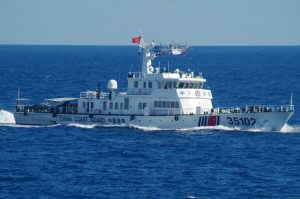By Tsuruta Jun

The Senkaku Islands, including the islands Uotsuri-jima, Kuba-shima and Taisho-jima, are a group of five islands and three reefs north of the Yaeyama Islands in Okinawa Prefecture. Based on both history and international law, the Senkaku Islands are part of the territory of Japan, and in fact Japan has effective control over them.
Following the United Nations Economic Commission for Asia and the Far East (ECAFE)’s survey report on coastal mineral resources in the fall of 1968, which suggested massive petroleum and gas reserves in the seabed areas around the islands, China’s Ministry of Foreign Affairs issued their “Statement concerning the issue of China’s sovereignty over the Diaoyu Islands” (the Chinese name for the Senkaku Islands) on December 30, 1971, marking the beginning of the Chinese government’s formal claims of sovereignty over the islands.
In the last few years, China Coast Guard (CCG) vessels have made repeated incursions into the territorial waters surrounding the Senkaku Islands and navigated in the contiguous zone. Here, I would like to point out the need for Japan to prepare for the future by reviewing the relevant movements in 2020.
CCG vessels operated inside the territorial sea surrounding the Senkaku Islands for 111 days, from April 14 to August 2, 2020. On several occasions, the vessels approached Japanese fishing boats operating in the sea surrounding the Senkaku Islands. Moreover, by November 2, the CCG vessels had entered and operated in the contiguous zone for a total of 283 days, setting a new record.
CCG vessels claim that they are exercising law enforcement activities in waters under the jurisdiction of China in accordance with Chinese laws. In a press briefing following talks between the foreign ministers of Japan and China on November 24, 2020, Chinese Foreign Minister Wang Yi made remarks to the effect that some Japanese fishing boats have repeatedly entered the waters surrounding the Senkaku Islands, and China had to respond. However, these law enforcement activities by CCG vessels have not yet taken the practical form of inspecting Japanese fishing boats in accordance with Chinese domestic laws and regulations, seizing the boats or arresting the Japanese fishermen. Even so, the “law enforcement activities” of the CCG vessels can be seen under international law as non-innocent passage into Japan’s territorial waters and an infringement of Japan’s sovereignty over its own territory. The CCG vessels do not have the right to enforce Chinese laws and regulations in the territorial waters of Japan.
Under the Japanese government’s no-escalation policy, Japan is dealing with the activities of the CCG vessels through the law enforcement activities of the Japan Coast Guard (JCG) in the sea areas, in accordance with the United Nations Convention on the Law of the Sea and the laws of Japan. In particular, the JCG restricts the courses of the CCG vessels as they intrude into the territorial waters of Japan and requests that vessels that have intruded exit Japan’s territorial waters.
However, the number of CCG vessels operating in the waters surrounding the Senkaku Islands, the length of their continuous presence in the area and the number of incidents in which the vessels came into close contact with Japanese fishing boats have all increased in 2020. The activities of the Chinese government are escalating the situation.
This situation was also recognized in the annual Defense of Japan white paper for 2020, approved at a Cabinet meeting in July 2020. It stated, “China has thus relentlessly continued attempts to unilaterally change the status quo by coercion in the sea area around the Senkaku Islands, leading to a grave matter of concern. Japan cannot accept China’s actions to escalate the situation.” Moreover, in the Japan-Australia Leaders’ Meeting Joint Statement dated November 17, 2020, the leaders expressed “strong opposition to any coercive unilateral actions that seek to alter the status quo and increase tensions” in the East China Sea.
How should Japan respond?
Japan needs to start by recognizing, analyzing and evaluating the situation surrounding the Senkaku Islands, precisely assess any change in the situation and use that assessment in its on-site responses. The fundamental purpose of Japan’s law enforcement activities at sea is to maintain maritime order; to secure the territory of Japan is very much a side effect of this. Paying attention to the limited scope of Japan’s responses through its maritime law enforcement activities, Japan will need to continue to deal effectively with the actions of the CCG.
Whatever may happen in the Senkaku Islands and the waters surrounding the islands in 2021, Japan’s policy and response should be beyond reproach, both domestically and internationally. Accordingly, starting now, Japan needs to bolster its own message.
Of course, it will be important to again confirm with the government of the United States that it interprets the U.S. commitment to protect Japan as encompassing the Senkaku Islands, as is stipulated in Article 5 of the Japan–U.S. Security Treaty. The joint exercises of Japan’s Maritime Self-Defense Force, the British Navy and the French Navy scheduled in 2021 in the East China Sea will also be significant.
Before that, though, Japan must make its own preparations.
Tsuruta Jun is an associate professor of international law at Meiji Gakuin University.
No comments:
Post a Comment